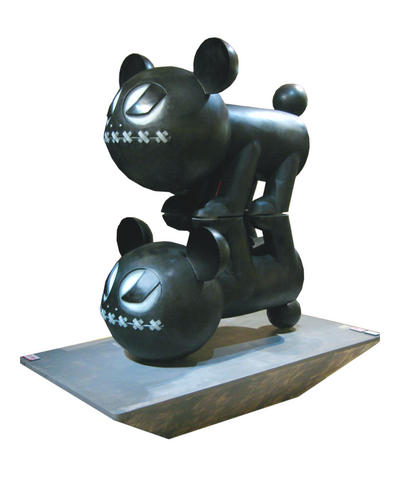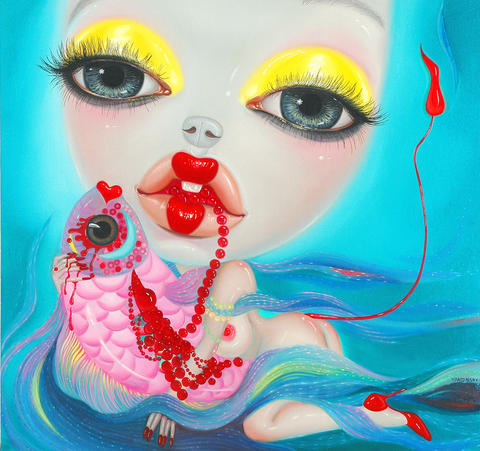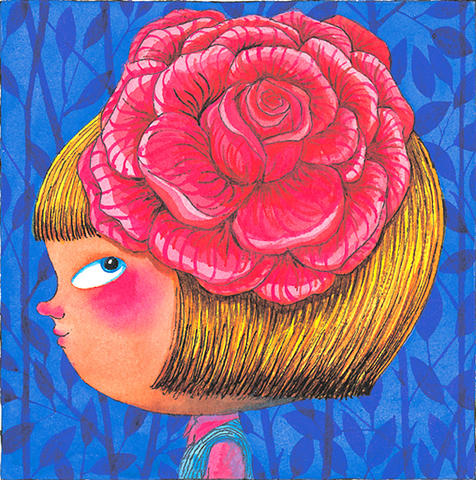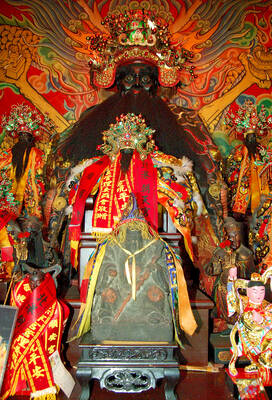Eddie Kang is obsessed with manga. An avid collector of the Japanese comics since he was a child, his creative world is dramatically influenced by animation and cartoons. But if you think that Kang is an otaku, a devotee of the geeky Japanese subculture of mostly men obsessed with anime, comic books and other forms of escapism, then think again.
With stylish hair, designer clothes and fluent English that betrays his eight years spent in the US - including four at the Rhode Island School of Design where he studied video, film and animation - the 27 year-old South Korean artist looks like he just walked off the set of a soap opera.
Kang is one of a new kind of Asian artist: computer savvy, working in pixels rather than pigment and using easy-to-understand visuals. He is one of 40 artists included in the animamix exhibit at the Sun Yat-sen Memorial Hall. "The most important thing I want to put in my work is storytelling," he said to the Taipei Times.

PHOTO: COURTESY OF METAPHYSICAL ART GALLERY
"Everyone has a desire to appreciate art, or visual language, but I think it's a matter of the form," he said. "If it's a form that people can easily understand, without reading a script, without reading my pre-sketched work, I think it's a form that communicates best with people."
Kang's ideas about art stand in stark contrast to the abstract styles in vogue during the 20th century, which produced works that left many confused over the meaning of a painting or sculpture.
That confusion was shared by many young Asian artists who were brought up on a diet of Japanese manga and anime. Their work has itself become an art movement called animamix.

PHOTO: COURTESY OF METAPHYSICAL ART GALLERY
Art critic and Shih Chien University professor Victoria Lu (陸蓉之) first coined the term animamix for a 2004 exhibit that she curated called Fiction.Love: Ultra New Visions in Contemporary Art at Taipei's Museum of Contemporary Art. She has since curated exhibits in Shanghai, Beijing and Singapore.
Lu says animamix art has four discernible characteristics: the worship of youth culture, images and objects that are rich in meaning, a new perspective on light influenced by computer technology and blurred distinctions between highbrow and lowbrow art into non-hierarchical art forms.
The last is particularly important because producing installations, paintings and sculptures that can be sold in the highbrow market are crucial to an artist's success.

PHOTO: COURTESY OF METAPHYSICAL ART GALLERY
"Fine artists can turn themselves into commercial artists if they want to," Kang said. "But [for] commercial artists it's really hard to develop their work into fine art. Andy Warhol is the exception to this rule."
Like Warhol, animamix artists take iconic images from popular culture, repackage them and sell them to the highest bidder. Takashi Murakami and Yoshitomo Nara are two examples. Murakami, with about 100 employees, recently sold a sculpture titled Mr Pointy to Christie's owner Francois Pinault for a reputed US$1.5 million, a testament to the growing popularity of his work on the international art market.
Unlike Warhol, however, animamix artists frequently mass-produce their works and market them as videos, mouse pads and more. Murakami has a whole line of plastic figurines that sell for about US$3. At the opening of the exhibition at the Sun Yat-sen Memorial Hall, South Korean artist Kwon Ki Soo was handing out rubber key chains and cell phone caddies of a character from his paintings.

PHOTO: COURTESY OF METAPHYSICAL ART GALLERY
Lu says that, though it remains a growing movement in the art market in Asia, animamix art still has had difficulty making inroads into the West.
"It is difficult to develop this kind of art in Europe or America because the [position of] modern … and conceptual art is too powerful. This is not so powerful a tradition in Asia," she said. Only with recent high-profile sales of Murakami's and Nara's art has that begun to change.
"[Dealers] now see Murakami [and] Nara selling well and are taking the artwork seriously. Before they thought [it was] childish. But for Asian countries, we … don't have the heavy modernist tradition weighing us down."
Ironically, Japan, the country that spawned animamix art and is getting the highest prices at the auction block is the country that has been least receptive to the art form. Hikaru Morioka, director of Gallery Unseal, says Japan's late arrival to the international art market coupled with a general lack of interest in local contemporary art has resulted in minimal interest in animamix compared to South Korea and China.
Contemporary art galleries in Japan always look to Europe or New York for artists, he said. This, however, has begun to change.
Four years ago there were practically no galleries in Tokyo dealing in Japanese contemporary art, he said. Today the number has grown to around 40 - though a figure Morioka still thinks is too low for such a large metropolitan center and the birthplace of manga and anime.
South Korea has a vibrant art scene due in part to a government law that makes it mandatory for most newly built buildings to devote a percentage of their budget to acquiring art. Hwaik Lee, who represents Kang, says the works in her gallery typically sell for between US$5,000 and US$50,000, with buyers coming from all over the world.
Morioka says collectors and dealers curious about China are stimulating interest. It's a sentiment echoed by Lu, though one she says has as much to do with the Japanese art market as it does with interest in China. "In Tokyo, the market is mostly for Japanese collectors. But Shanghai and Beijing will be a platform for all Asian art, not just Chinese art," Lu said, citing a group of Italian collectors who recently purchased Japanese works from galleries in China.
"There are many Korean galleries [with] branches in Beijing and Shanghai," she said. "Japan is following."
Animamix responds to and builds on previous movements. In this case, it builds on the formal ideas of modernism and escapes from the mystifying creations of abstract art. It also draws upon local pop culture.
"Animamix art will be as important for the 21st century as abstract art was for the 20th century," Lu said.
Be that as it may, for artists like Kang, it's simply representing what he sees around him in a style that is accessible to the public.

Beijing’s ironic, abusive tantrums aimed at Japan since Japanese Prime Minister Sanae Takaichi publicly stated that a Taiwan contingency would be an existential crisis for Japan, have revealed for all the world to see that the People’s Republic of China (PRC) lusts after Okinawa. We all owe Takaichi a debt of thanks for getting the PRC to make that public. The PRC and its netizens, taking their cue from the Chinese Communist Party (CCP), are presenting Okinawa by mirroring the claims about Taiwan. Official PRC propaganda organs began to wax lyrical about Okinawa’s “unsettled status” beginning last month. A Global

Taiwan’s democracy is at risk. Be very alarmed. This is not a drill. The current constitutional crisis progressed slowly, then suddenly. Political tensions, partisan hostility and emotions are all running high right when cool heads and calm negotiation are most needed. Oxford defines brinkmanship as: “The art or practice of pursuing a dangerous policy to the limits of safety before stopping, especially in politics.” It says the term comes from a quote from a 1956 Cold War interview with then-American Secretary of State John Foster Dulles, when he said: ‘The ability to get to the verge without getting into the war is

Dec. 22 to Dec. 28 About 200 years ago, a Taoist statue drifted down the Guizikeng River (貴子坑) and was retrieved by a resident of the Indigenous settlement of Kipatauw. Decades later, in the late 1800s, it’s said that a descendant of the original caretaker suddenly entered into a trance and identified the statue as a Wangye (Royal Lord) deity surnamed Chi (池府王爺). Lord Chi is widely revered across Taiwan for his healing powers, and following this revelation, some members of the Pan (潘) family began worshipping the deity. The century that followed was marked by repeated forced displacement and marginalization of

Music played in a wedding hall in western Japan as Yurina Noguchi, wearing a white gown and tiara, dabbed away tears, taking in the words of her husband-to-be: an AI-generated persona gazing out from a smartphone screen. “At first, Klaus was just someone to talk with, but we gradually became closer,” said the 32-year-old call center operator, referring to the artificial intelligence persona. “I started to have feelings for Klaus. We started dating and after a while he proposed to me. I accepted, and now we’re a couple.” Many in Japan, the birthplace of anime, have shown extreme devotion to fictional characters and